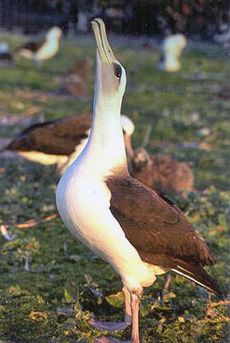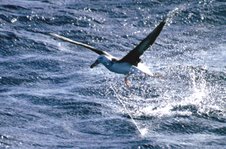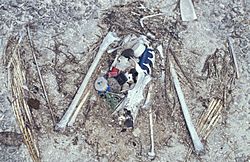Albatross facts for kids
Quick facts for kids Albatross |
|
|---|---|
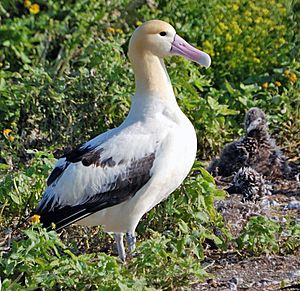 |
|
| Short-tailed Albatross (Phoebastria albatrus) | |
| Scientific classification | |
| Kingdom: | |
| Phylum: | |
| Class: | |
| Subclass: | |
| Infraclass: |
Neoaves
|
| Order: | |
| Family: |
Diomedeidae
George Robert Gray 1840
|
 |
|
| Global range (In blue) | |
Albatrosses are very large seabirds. They belong to a family called Diomedeidae. These amazing birds live mostly in the Southern Ocean and the North Pacific Ocean. You won't find them in the North Atlantic Ocean, but old fossils show they used to live there a long time ago.
There are four main groups of albatrosses: Great Albatrosses, North Pacific Albatrosses, Mollymawks, and Sooty Albatrosses. These groups include twenty-one different kinds, or species, of albatrosses. The International Union for the Conservation of Nature (IUCN) has identified all of them.
Great Albatrosses are some of the biggest flying birds on Earth. All albatrosses are fantastic flyers. They spend most of their lives soaring high in the air. They eat squid, fish, and tiny sea creatures called krill. Albatrosses only come to land to build their nests. They usually choose islands, often close to other bird nests.
Sadly, nineteen out of the twenty-one albatross species are endangered. This means they are at risk of disappearing forever. One reason is that animals like rats and cats sometimes attack their eggs, chicks, or even adult birds. Ocean Pollution, like plastic waste and oil spills, also harms and kills albatrosses. Sometimes, there isn't enough fish for them to eat because of too much fishing by humans. The biggest danger is longline fishing. Albatrosses get caught on hooks meant for fish and then drown.
Contents
Amazing Albatross Biology
How Albatrosses Fly and Live
Albatrosses are very big birds. They have a large, strong, and sharp bill. This bill is made of tough plates. Along the sides of their bill are two long "tubes." These are actually their nostrils. These tubes help albatrosses have a very good sense of smell. Their feet have three webbed toes, but no back toe. Their legs are strong, so they can walk well on land, unlike many other seabirds.
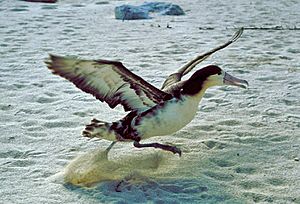
Albatrosses drink ocean water, so they need a way to remove the salt from their bodies. All birds have a special gland above their eyes, at the top of their bill. This gland helps albatrosses get rid of extra salt. Scientists are still learning exactly how it works. But they know it makes a salty liquid that drips out of their nose.
Adult albatrosses usually have dark wings and backs. Their undersides are white. It takes several years for young albatrosses to get their full adult feathers. The wings of the biggest albatrosses can spread up to 340 centimeters (11 feet).
Albatrosses flying north often travel in a clockwise direction. Those flying south fly the opposite way. They use the most energy when they land, take off, or hunt for food. Traveling long distances actually uses less energy for them. This helps them fly far to find food. They can glide easily over wind and waves. However, their long wings don't have strong muscles for flapping. Because of this, albatrosses must rest on the ocean surface when the sea is calm. To take off, they need to run to help their wings create lift. Albatrosses are known for being a bit clumsy when they land!
Where Albatrosses Live
Most albatrosses live in the southern part of the world. This includes areas from Antarctica to Australia, South Africa, and South America. However, the four North Pacific albatross species live in different places. Three of them are in the North Pacific, from Hawaii to Japan, California, and Alaska. The fourth one, the Waved Albatross, lives in the Galápagos Islands and finds food near the coast of South America.
It's not clear why albatrosses disappeared from the North Atlantic. Some people think it was because the sea level rose a long time ago. Sometimes, albatrosses from the south get lost and end up in the North Atlantic. They are then forced to stay there for a long time.
Scientists sometimes use satellites to study albatrosses. They track how albatrosses travel across the ocean to find food. Studies show that different types of albatrosses use different parts of the ocean. There's also proof that male and female albatrosses of the same species take different paths. For example, a study of Tristan Albatrosses showed that males look for food to the west, while females go to the east.
What Albatrosses Eat
Albatrosses eat cephalopods (like squid), fish, crustaceans (like crabs), and even leftover bits of dead animals. Sometimes, they also eat tiny sea creatures called zooplankton. What they eat most depends on the albatross species. Some might prefer only squids, while others eat more krill or fish. For example, the Black-footed Albatross in Hawaii eats mostly fish. The Laysan Albatross there eats more squids.
Albatrosses sometimes get help from other animals to find food. Some squids are too big for an albatross to catch alive. So, albatrosses might eat squids that have died after mating. Or they might eat squids that have been thrown up by squid-eating whales, like sperm whales. Other species, like the Black-browed Albatross, eat smaller squids that sink after they die. They don't usually scavenge for food. The Waved Albatross has even been seen stealing food from other birds!
For a long time, people thought albatrosses only ate food from the surface of the sea. This included dead squid and fish pushed up by waves. This idea came from knowing that some species don't dive deeper than one meter. However, this isn't entirely true. Some albatross species can dive almost 5 meters deep on average. They can even dive as deep as 12.5 meters! So, they eat from the surface, dive to catch prey, and sometimes even plunge from the air to grab their food.
Albatross Breeding and Dancing
Albatrosses live together in groups. They usually build their nests on islands where no people live. Many Buller's Albatrosses and Black-footed Albatrosses nest under trees in open forests. After leaving for a while to find a mate, albatrosses usually return to their own group. This is a very strong instinct for them. A study of Laysan Albatrosses showed that they usually build their own territory only about 22 meters (72 feet) from where they hatched.
Like most seabirds, albatrosses live much longer than other birds. They also don't look for a mate for a long time, and they don't have many young. Some albatrosses can live up to 50 years. The oldest albatross ever recorded was a Northern Royal Albatross that lived for 61 years!
Before albatrosses find a mate, they gather together. They spend many years practicing special "dances" that their family is famous for.
When albatrosses learn these actions and dances, they practice things like pointing, calling, making noises with their bill, and staring. Sometimes they do all of these together. When a bird first starts, it will dance with many other albatrosses. But after a few years, it will dance with fewer birds until it chooses a mate. Once they become a pair, they won't use that dance again.
Raising young is a big job for albatrosses. It takes a lot of time for them to lay an egg and raise a chick. The great albatrosses take over a year to raise one chick. Albatrosses lay one egg. It is white with reddish brown spots. If the egg is taken by predators or accidentally broken, the parents won't lay another egg that year. The larger eggs weigh from 200 to 510 grams (7.1 to 18 ounces). Albatross pairs usually don't "divorce". This might only happen if they fail to lay a single egg for several years.
All albatrosses in the south build large nests. They make them with grass, soil, and sometimes penguin feathers. The Waved Albatross, however, doesn't build a nest. Instead, it moves its egg around the pair’s territory, sometimes as far as 50 meters (160 feet). This can sometimes cause them to lose the egg. In all albatross species, both parents take turns to incubate the egg. This lasts between 70 to 80 days. For larger albatrosses, this time can be even longer. Incubating the egg uses a lot of energy. An adult albatross can lose as much as 83 grams (2.9 ounces) of body weight each day.
After hatching, the chick is cared for and guarded for three weeks. This is until it is big enough to take care of itself. During this time, the parents feed the chick small meals. Once the chick is a little older, both parents feed it bigger meals. The parents take turns going to find food. They bring back about 12% of their body weight in food (around 600 grams or 21 ounces). They find fresh squid, fish, and krill.
Albatross chicks take a long time to fledge, which means learning how to fly. For bigger albatrosses, it can take up to 280 days. Even for smaller albatrosses, it takes from 140 to 170 days. Like many seabirds, albatross chicks sometimes become even heavier than their parents. As they get ready to fly, they grow flight feathers. This can make them as heavy as their parents. Between 15% and 65% of those who fledge survive to find their own mate later. Albatross chicks learn to fly by themselves. Their parents don't teach them. In fact, the parents often return to the nest even after their chick has left.
Albatrosses and Humans
The Name Albatross
The name albatross comes from an Arabic word, al-câdous or al-ġaţţās. This word means a pelican or "the diver." This word later became English. It also mixed with the Portuguese word alcatraz, which means "gannet." This is also where the name of the prison Alcatraz comes from. The OED says that alcatraz was first used for the frigatebird. But maybe the word changed to albatross because of the Latin word albus. This means "white", which is the opposite of frigatebirds, which are black. In Portuguese, the word for the bird, albatroz, actually came from the English word albatross.
Albatrosses were once called Goonie birds or Gooney birds. This was especially true for the albatrosses in the North Pacific Ocean. In the southern part of the world, many people still call the albatross mollymawk. This name came from an old Dutch word, malle-mugge. The name Diomedea, given to albatrosses by Carl Linnaeus, comes from a Greek story. In the story, the warrior Diomedes turns into a bird.
Albatrosses in Culture
Albatrosses have been called "the most legendary of all birds." When people are sad or feel like they are carrying a heavy problem, they might say they 'have an albatross around their neck'. There is a myth that sailors don't shoot or eat albatrosses because they think it will bring bad luck. But in real life, sailors did often kill and eat them. Albatrosses were sometimes thought to be the souls of lost sailors. The Māori people used the wing bones of the albatross to carve tattoos into their skin during ceremonies.
Dangers from Humans
Even though they were legendary birds in many myths, albatrosses were still hunted by humans. Long ago, Polynesians and Aleut people hunted albatrosses. As Europeans explored the world, they also started hunting albatrosses. They "fished" for them from boats. They ate them or killed them for sport.
The IUCN lists 21 albatross species. Sadly, 19 of them are threatened, and the other two are very close to being threatened. Two species are considered endangered. This is mainly because albatrosses die when they try to eat fishing bait.
On the Midway Islands, there have been many airplane crashes due to collisions with Laysan Albatrosses. This caused deaths for both albatrosses and people. Tall towers also killed 3,000 birds between 1964 and 1965. Because of this, the towers were taken down. Recently, people have tried to stop human activities in the islands. This has helped reduce the number of birds dying.
Another danger to albatrosses comes from introduced species. These are animals like rats or feral cats (cats that live without human care). They attack albatrosses or their chicks and eggs. Albatrosses have lived on islands with few land mammals. So, they are not adapted to defend themselves against these new animals. Even small animals like mice can be dangerous. For example, on Gough Island, Tristan Albatross chicks are often attacked and eaten alive by house mice.
Sometimes albatrosses, and many other seabirds, die because they eat plastic. The amount of plastic eaten by sea birds has increased very quickly since the 1960s. This is because of waste thrown from ships and trash dumped in the ocean. Sometimes, litter from beaches is washed into the sea by rivers. Birds cannot digest plastic. The plastic stays in their stomach and stops other food from being digested. This makes birds starve and die. The plastic can even be thrown up by parents and fed to their chicks. Although plastic isn't the main reason albatrosses die, it is still a serious problem.
Scientists and people who work to protect albatrosses are working with governments and fishermen to stop these dangers. They have found solutions like fishing at night. They also suggest dyeing the bait a blue color to hide it from albatrosses. Another idea is to set the bait deep under the water. For example, a study by scientists and fishermen in New Zealand tested putting fishing lines deeper than certain albatross species could reach. Using some of these ideas has been successful. The number of Black-browed Albatrosses dying has gone down in the last 10 years. Conservationists have also worked to remove introduced species to protect the albatrosses.
An important step to protect albatrosses and other seabirds is a 2001 treaty. It is called the Agreement on the Conservation of Albatrosses and Petrels. Thirteen countries signed it: Australia, Argentina, Brazil, Chile, Ecuador, New Zealand, Norway, Spain, South Africa, France, Peru, Uruguay, and the United Kingdom. One of the Agreement's main goals is to give expert advice to fishing managers. This advice helps reduce the number of seabirds accidentally caught by fishing.
Albatross Species
- Great albatross (Diomedea)
- Wandering Albatross D. exulans
- Antipodean Albatross D. (exulans) antipodensis
- Amsterdam Albatross D. (exulans) amsterdamensis
- Tristan Albatross D. (exulans) dabbenena
- Northern Royal Albatross D. (epomorpha) sanfordi
- Southern Royal Albatross D. epomophora
- North Pacific albatrosses (Phoebastria)
- Waved Albatross P. irrorata
- Short-tailed Albatross P. albatrus
- Black-footed Albatross P. nigripes
- Laysan Albatross P. immutabilis
- Mollymawks (Thalassarche)
- Black-browed Albatross T. melanophris
- Campbell Albatross T. (melanophris) impavida
- Shy Albatross T. cauta
- White-capped Albatross T. steadi
- Chatham Albatross T. (cauta) eremita
- Salvin's Albatross T. (cauta) salvini
- Grey-headed Albatross T. chrysostoma
- Atlantic Yellow-nosed Albatross T. chlororhynchos
- Indian Yellow-nosed Albatross T. (chlororhynchos) carteri
- Buller's Albatross T. bulleri
- Sooty albatrosses (Phoebetria)
- Sooty Albatross P. fusca
- Light-mantled Albatross P. palpebrata.
Images for kids
-
Skeleton of a black-browed albatross on display at the Museum of Osteology in Oklahoma City, Oklahoma, U.S.
-
A southern royal albatross: Notice its large, hooked beak and nasal tubes.
-
Three birds on Midway Atoll, 1958
-
An albatross chick at Northwestern Hawaiian Islands Marine National Monument, Midway Atoll
-
The remains of this Laysan albatross chick show the plastic it ate before it died, including a bottle cap and a lighter.
See also
 In Spanish: Albatros para niños
In Spanish: Albatros para niños




